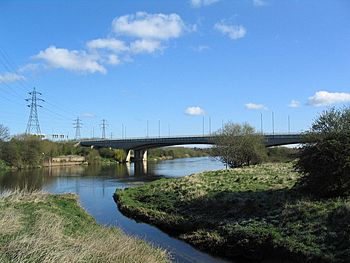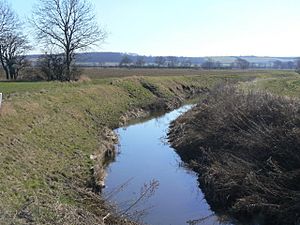Fairham Brook facts for kids
Quick facts for kids Fairham Brook |
|
|---|---|

Confluence of the Fairham Brook with the River Trent
|
|
| Country | England |
| Counties | Leicestershire, Nottinghamshire |
| District | Rushcliffe |
| Villages | Widmerpool, Bunny |
| Physical characteristics | |
| Main source | Old Dalby, Leicestershire |
| River mouth | Silverdale, Nottinghamshire 52°55′26″N 1°10′02″W / 52.9238°N 1.1672°W |
| Length | 26 km (16 mi) |
| Basin features | |
| Basin size | 80 km2 (31 sq mi) |
| Tributaries |
|
| Progression : Fairham Brook—Trent—Humber | |
The Fairham Brook is a small river, about 26 kilometers (16 miles) long. It flows through the counties of Leicestershire and Nottinghamshire in England. This brook is a tributary, which means it's a smaller river that flows into a larger one. The Fairham Brook eventually joins the mighty River Trent.
Contents
Journey of the Fairham Brook
The Fairham Brook begins its journey in Leicestershire. Its source is found on the edge of the Nottinghamshire Wolds, near a place called Old Dalby.
Flowing North and West
At first, the brook flows towards the north. Then, it makes a turn and starts flowing west. On its way, it passes through the villages of Widmerpool and Bunny.
Across the Moors
The brook then crosses an area known as Bunny and Ruddington moor. After this, it flows north again. You can find it between the area of Clifton and the village of Ruddington.
Joining the Trent
Finally, the Fairham Brook reaches its end. It joins the River Trent near Silverdale, which is on the edge of Nottingham. This meeting point is close to Clifton Bridge.
The Brook's Water Area
The area that collects water for the Fairham Brook is called its catchment. This catchment covers about 80 square kilometers (31 square miles). It sits between the areas of the Polser Brook and River Smite to the north, and the Kingston Brook to the south.
Smaller Streams
The Fairham Brook has several smaller streams that flow into it. Most of these streams don't have special names. However, a few do!
- One stream comes from Gotham and is known as the Gotham Brook.
- Another stream flows between Ruddington village and Mickleborough Hill. This one is called Packman's Dike.
- The Nethergate Brook collects water from the Clifton estate.
The Moors Landscape
In the middle part of its journey, the brook drains a flat, wetland area called "The Moors." This area includes Ruddington, Bunny, Bradmore, and Gotham moors. Farmers use special drainage systems to manage the water in these moors. The Fairham Brook acts like a main channel for this water.
Wildlife and Nature
The Fairham Brook is important for local wildlife. There are special places along its banks that are protected for nature.
Clifton Nature Reserve
Near Clifton, there is a local nature reserve. This area has wetlands and scrubland. Kingfishers, which are beautiful birds with bright blue and orange feathers, have been seen near the brook here.
Keyworth Meadow
Another nature reserve next to the brook is called Keyworth Meadow. This meadow is home to turtle doves. These birds are known for their soft cooing sounds.
Clifton Grove
In the 1600s, a bridge over the Fairham Brook marked the start of Clifton Grove. This was once a long path lined with elm trees. It led to Clifton Hall. Sadly, many elm trees were lost to a disease.
Today, Clifton Grove is still a special place for wildlife. It has other trees like oaks, chestnuts, and even giant redwoods. It's now a local nature reserve. It connects with other nature spots along the River Trent, like Clifton Wood and Holme Pit.
Water Quality
Scientists check the health of rivers and brooks. The Fairham Brook has been rated as having poor ecological quality. This means its environment isn't as healthy as it could be for plants and animals. There are five levels of quality, from high to bad, and poor is one of the lower levels.


